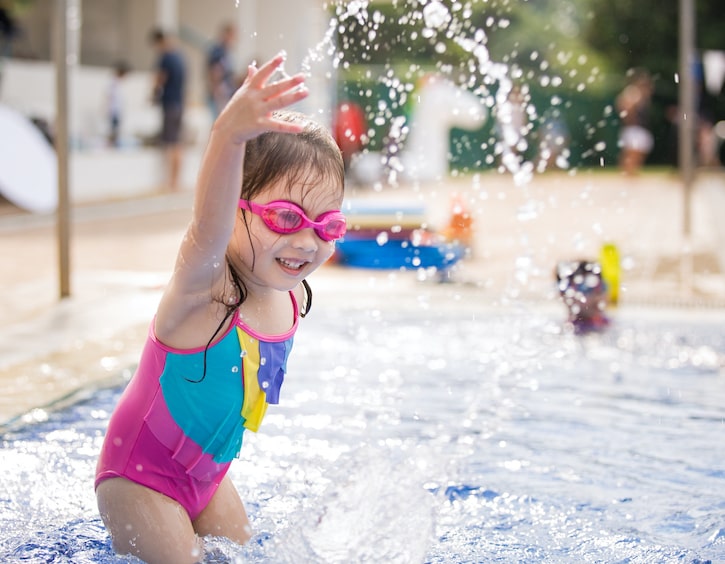
aquaDucks swim school shares five skills you can teach your kids to help them learn to swim and become water confident. Plus ‘learning to swim’ dos and don’ts.
Learning to swim is one of those life lessons that opens up a whole new level of fun. Whilst us parents should always supervise young kids at the swimming pool, having basic swim skills is key for water safety. So what can you do to help your kids learn to swim? We spoke to the swim coaches at aquaDucks (who have been teaching kids to swim since 1989!) to find out how to help kids become water confident while having fun.
Five important skills you can teach your kids to help them learn to swim
You may be eager to get on with official swimming lessons for your child, but you can also start helping your kids learn these initial swim skills to get your little one water confident – which is really the first step in learning how to swim.
Swim Skill #1: Holding your breath
Teaching kids to hold their breath under water is an important step in learning how to swim. Once your child can hold their breath, they can start to relax and be comfortable with their face in the water. Only when kids master this step will they be ready for the next stage of learning to swim.
How: First get your child comfortable with having water on their face. At bath time you can practice by pouring water over their face after saying the same cue words each time. You might say “1, 2, 3 weee!” or “Ready steady go!”. Once you child is ok with water going over their face, you can get them comfortable with being in the water at a pool. Remember to use the same cue words and then ask them to hold on to the wall and put their face in the water. The next step would be asking your child to let go of the wall and then, again with the same cue words, gently submerging them under water.
Swim Skill #2: Floating on your back
Being able to float on your back is another core part of water safety.
How: Get your child to lie on their back in the water with their head resting on your shoulder. Then slowly move so that you are holding the back of their head with your hands. Once they are relaxed, you can start to let go. To make it fun, touch your kid’s nose with a finger, pretending that you have a magic finger that can hold them on top of the water. Singing a song each time can be a fun way to do this activity too. Sing ‘twinkle twinkle little stars’ together and look up to the sky and see who can spot any stars (wink wink).

Swim Skill #3: Jump in and turn back to the wall
Fingers crossed an accident will never happen but if it does, we want to make sure that our kids are able to swim back to safety. By practicing jumping into the pool and immediately turning around back to the wall, we are training our kids to stay calm and know what to do if they fall into the pool by accident. The movement of returning back to the wall almost becomes part of their muscle memory.
How: You may do this once your child is able to submerge and propel forwards in the water. Ask your child to jump into the swimming pool, go under water and then help them to immediately turn back to the wall and place their hands on the side of the pool wall. To make it fun you can incorporate toys too. Let them jump into the swimming pool, catch the toy, and turn back to hold onto the wall.
Swim Skill #4: Open eyes in water
Being able to open your eyes in the water is another key water safety skill. If your child falls into the swimming pool (or sea!) they need to be able to open their eyes to know where safety is (turn back to the wall, ladder, steps).
Tip: If you have never introduced googles to your kids, you’re one step closer to achieve this skill.
How: For little ones, you can hold a toy in the water about 1m below the surface and ask them to go under water and get it from you. If your child knows their numbers, you can get them to look under water while you hold up a number of fingers and ask them to tell you how many they saw.
Swim Skill #5: Monkey hands
Hanging onto the side of the wall and moving from one point to another is an important water safety skill to have when you are learning to swim. It helps the kids return to safety when they are running out of energy. So instead of pulling their body weight up out of the swimming pool, they can just do monkey hands (walking their hands) to the stairs/ladder/steps.
How: Tell your little one that they can now be a cheeky monkey (or for older kids spiderman/spiderwoman) and ask them to face the pool wall and slowly “walk” their hands one at the time along the pool side always maintaining contact with the pool side as they move from one side of the pool to the pool steps.

Learning to swim DOs & DON’Ts from aquaDucks swim coaches
- Do watch your child at ALL times when they are in and around the pool (or any water source).
- Do make swimming an essential life skill.
- Do allow and encourage your child to explore the water (with proper supervision).
- Don’t leave children unattended around a pool even for a minute (put that mobile phone away).
- Don’t protect children from getting their face wet.
The aquaDucks swimming programme (established in 1989) has been developed by taking the best of USA, European, and Australian teaching styles resulting in a world class swimming programme. Babies as young as 6 months can start swim lessons while there are six levels for kids aged five and above. If you are interested to get your kids swimming, book a swim trial here.
Pricing/Fees: $150 per month (weekdays) / $160 per month (weekends)
Locations: Dempsey, Turf City, Newton, Kent Ridge or Queenstown.
aquaDucks, [email protected], www.aquaducks.com.sg






 View All
View All





 View All
View All










 View All
View All





![[𝗛𝗢𝗧 𝗡𝗘𝗪𝗦] 𝗦𝗲𝗻𝗴𝗸𝗮𝗻𝗴 𝗦𝘄𝗶𝗺𝗺𝗶𝗻𝗴 𝗖𝗼𝗺𝗽𝗹𝗲𝘅 𝗶𝘀 𝗕𝗔𝗖𝗞 𝘄𝗶𝘁𝗵 𝗡𝗘𝗪 𝗦𝗟𝗜𝗗𝗘𝗦 & 𝗙𝗘𝗔𝗧𝗨𝗥𝗘𝗦! 💦🔥
One of the most popular pools in the North-East is finally back and it’s even better than before! Brand-new slides for thrill-seekers (1.2m+), splash zones for little ones, a Jacuzzi, sheltered teaching pool, and an Olympic-sized pool for serious swimmers.
Say goodbye to the rainbow slides as the new ones are faster, wider & way more fun! Just remember: proper swimwear only, and no accessories for max sliding speed.
𝗪𝗵𝗲𝗿𝗲: 57 Anchorvale Rd, Singapore 544964 (5 mins from Sengkang LRT)
𝗪𝗵𝗲𝗻: Tues/Thurs/Sat: 6.30am – 9.30pm | Wed/Fri/Sun: 8am – 9.30pm | Mon: Closed
𝗛𝗼𝘄 𝗺𝘂𝗰𝗵: Family of 4 (weekend) = Just $7!
Tag your splash squad & get ready for a wave of fun! 🏄♂️
.
.
.
.
.
.
.
#SengkangSwimmingComplex #SGPools #FamilyFunSG #WaterPlaySG #NorthEastLiving #SengkangReopens #KidsActivitiesSG #SengkangFun #publicswimmingpool](https://www.sassymamasg.com/wp-content/plugins/instagram-feed/img/placeholder.png)
